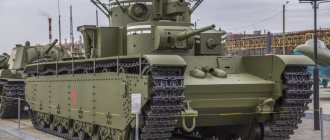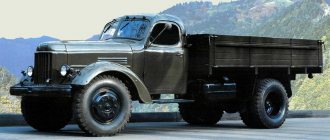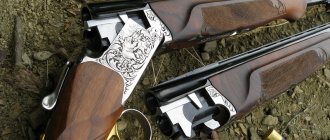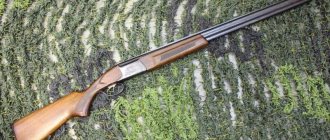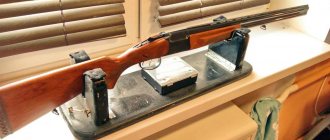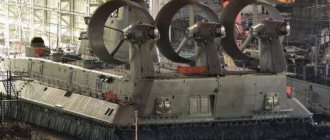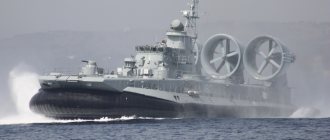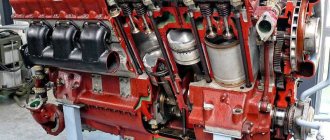There were posts about Sherpas, but they were superficial without any significant details. I'll try to reveal the Sherpa design a little. So, even though it’s a bayan-babayan, but for me, anything is better than boobs every 3 posts) All photos are taken from open sources and are far from the best quality, you’ll have to be content with what you have.
First of all, I'll start with the basics - the frame. The base of the frame is a pipe with a diameter of 108 mm.
In addition to its main function as a supporting structure and frame for the body with units, it also plays the role of a so-called “pneumatic circulation” suspension, serving as an air duct between the wheels, and exhaust gases are also supplied through it for pumping them up. Fully inflating the wheels from zero pressure takes about 30 seconds, with a total volume of 4 wheels being 3200 liters, this is almost instant) when compared with the time of inflating through the axle shaft on conventional automobile axles.
The photo shows the channels (circled in red) through which rubber pipes supply air to the hollow wheel shaft with an outer diameter of 75 mm and an internal diameter of 55 mm (the wheel bearing housings are circled in green) and, accordingly, the wheel.
The same pipes are visible here
Skid steering provides amazing maneuverability for an all-terrain vehicle of this size, although it is not without its drawbacks. When turning, there is a break in the flow and it is no longer 4 wheels that row, but only 2, but in serious swamps on any vehicle they move almost straight and generally correct the direction slightly, in other cases this drawback is not particularly significant.
But the most important advantage of the Sherpa is its mass. 1350 kg on 4 wheels 1600×600 provide amazing cross-country ability, allow you to drive through any swamps, and very easily get from water to ice. This became possible only with a side-swivel design and with the refusal to use traditional automotive components in the transmission (axles, cardans, differential, transfer case, etc.) with the transition to chain drives, which are more reliable and can withstand heavy loads with less weight. All-terrain vehicles made according to the automotive scheme on similar wheels have a mass approaching 2 tons, this while maintaining adequate reliability; if you try to remove the mass, then problems arise of insufficient transmission strength, which is fraught with trouble in serious off-road conditions)))
Well, that’s enough for now, if there is interest, I’ll write about the remaining nuances. There are also very interesting all-terrain vehicles Trom-8, Lesnik, Predator, which have their own distinctive features, when I have time I will make posts about them.
Off-road vehicles are of great interest to both the military and various civilian structures. New models of all-terrain vehicles appear quite often; they are developed by both well-known manufacturing companies and single enthusiasts who are in love with their work. One of the most interesting new products in recent years has been the Russian wheeled all-terrain vehicle “Sharp”, created by St. Petersburg engineer Alexei Garagashyan. Development of the all-terrain vehicle began in 2012, and this vehicle was first presented to the general public in 2022.
Alexey Garagashyan is a fairly well-known personality among lovers of all-terrain vehicles. He has several all-terrain vehicles with very high cross-country characteristics. However, it was the “Sherp” that became the designer’s most successful development; today this machine is mass-produced and is in quite good demand. This all-terrain vehicle has an original design, which is a successful mix of proven and original technical solutions.
In terms of cross-country ability, this Russian wheeled all-terrain vehicle is not only not inferior to tracked models of similar equipment, but also surpasses them in many ways. In addition, this machine is compact, has an excellent level of maneuverability, reliability and has a very spacious interior for its size.
Serial production of "Sherpa" has been established in St. Petersburg.
AutoPodborPenza › Blog › Sherpa. Dreams Come True
I’ll take a break from civilian cars and write to you about the equipment that has sunk into my soul.
I'll share my thoughts about it. Hello. Today HE will be on the blog: You know, for the last 30 years it has been customary to vilify Russian technology in everything. Often manufacturers themselves give reasons for this. I am also dissatisfied with many things and I think that Russia is really good at making tanks, planes and other military equipment. But this is different. Almost half the country is working on their invention and production so that we can feel protected from external enemies.
And here is quite a civilian all-terrain vehicle and MADE IN RUSSIA. The first impression when you see it is childish delight, as if the toy had been enlarged! The wheels are almost as tall as me! Despite the fact that the car is not that high, only 2300 mm. And the wheels are 1600 mm - two-thirds of his height.
When I examined him, I was truly overcome with some kind of childish pride. The thought was “all is not lost yet”
After all, the customer for the development of this miracle was not the army or the authorities. It was invented by just one person, like you, like me, or anyone else you cross paths with on the streets of our cities. A person who really loves his job.
Look at him. He is not at all like Tony Stark and other freakish movie heroes that we are fed in batches every year. Not a billionaire, but definitely a Genius.
Why does “all is not lost” cause pride?
For me, he is perceived as a modern “left-hander”. Invented and implemented. I don’t know how it happened for sure, but a fact is a fact. Without any pathos, like Prokhorov and without the state. support like AvtoVAZ, Garagashyan and his comrades found ways to realize their dreams. They did it. There were investors who believed in him and invested money in his ideas. In the end, they succeeded. And we can see it:
And this is really business and production. And not the modern buy-sell-get 300%, which has already fed up everyone. There is a small factory and production. They say they have already sold 500 of them. The volume is small, but this is not surprising. When I heard the price, I thought I had misheard and asked again. It turned out that it didn't seem like it. 6,200,000 rubles
. Despite the price, something tells me that everything from them will only continue to grow.
The ideas are Russian, but not everything is Russian. Alas.
The engine is Japanese Kubota diesel and produces only 44 horses. Surprisingly, this is quite enough. But the consumption is a ridiculous 3 liters per hour with a total maximum tank volume of 232 liters. Simple arithmetic and it turns out that a Sherpa can move for three days without stopping at all at a speed of up to 45 km per hour. The theoretical range without refueling is about 3000 km.
Named and patented wheels
They are not made here either.
This is what they look like when deflated
They are pumped up very quickly by engine exhaust gases. It looks like this: the driver turns the switch, the engine begins to roar strainedly at high speeds, and the Sherpa gets up from his knees before your eyes in just a minute.
The body is made the same way abroad. They say they couldn’t find reliable performers and sent it to foreign production.
What is ours then?
Probably everything else.
For example, a caliper from a V8:
But where are they located if it does not have brake discs?
On the sides there is a chain drive to the front and rear wheels. On the other hand it looks like a mirror.
Everything you see below is also Russian.
Sherpa. Design overview.
First of all, I'll start with the basics - the frame. The base of the frame is a pipe with a diameter of 108 mm.
In addition to its main function as a supporting structure and frame for the body with units, it also plays the role of a so-called “pneumatic circulation” suspension, serving as an air duct between the wheels, and exhaust gases are also supplied through it for pumping them up. Fully inflating the wheels from zero pressure takes about 30 seconds, with a total volume of 4 wheels being 3200 liters, this is almost instant) when compared with the time of inflating through the axle shaft on conventional automobile axles.
The photo shows the channels (circled in red) through which rubber pipes supply air to the hollow wheel shaft with an outer diameter of 75 mm and an internal diameter of 55 mm (the wheel bearing housings are circled in green) and, accordingly, the wheel.
The same pipes are visible here
Skid steering provides amazing maneuverability for an all-terrain vehicle of this size, although it is not without its drawbacks. When turning, there is a break in the flow and it is no longer 4 wheels that row, but only 2, but in serious swamps on any vehicle they move almost straight and generally correct the direction slightly, in other cases this drawback is not particularly significant.
But the most important advantage of the Sherpa is its mass. 1350 kg on 4 wheels 1600x600 provide amazing cross-country ability, allow you to drive through any swamps, and very easily get from water to ice. This became possible only with a side-swivel design and with the abandonment of the use of traditional automotive components in the transmission (axles, cardans, differential, transfer case, etc.) with the transition to chain drives, which are more reliable and can withstand heavy loads with less weight. All-terrain vehicles made according to the automotive scheme on similar wheels have a mass approaching 2 tons, this while maintaining adequate reliability; if you try to remove the mass, then problems arise of insufficient transmission strength, which is fraught with trouble in serious off-road conditions)))
Video selection
Karakat-all-terrain vehicle based on the Neva walk-behind tractor:
A lightweight all-terrain vehicle with the working title “Bruise”, as the body is sheathed in polycarbonate. In general, this is the first model where this light, warm and more or less durable material was used. So far there are no complaints about polycarbonate, this plastic should withstand frosts of up to 40 degrees and does not deteriorate in the sun, most importantly, it is much lighter than any iron and aluminum and cheaper.
The all-terrain vehicle turned out to be quite light for its size, capacity and large wheels. Approximate weight is about 600kg. Dimensions: length-3400 mm, width-1960 mm, cabin height 2100 mm, kung height 2350 mm.
Technical characteristics of the all-terrain vehicle
Rotation method
— “fracture” of the frame on the UAZ kulak Wheel formula
— 4×4, permanent all-wheel drive
Dimensions
— L*W*H /3400*1960*2350
Curb weight
— 650 kg
Load capacity
— land/water 300/150 kg
Maximum speed
— land/water 25/1 km/h
Engine
— IZH -Planeta3, converted to liquid cooling
Chain gear
- chain pitch 19.05 mm, gearbox inverter = 2.13
Drive axles
- M-412, main pair inverter = 3.9 Tires
-
Bel-79 1020*420-18, tubed
Discs
- homemade
Frame
- spatial, welded, made of profile pipes
Cabin
- semi-closed, single-seater
Body
- semi-closed, lined with polycarbonate
Important Husqvarna chainsaws
The all-terrain vehicle was built as a simple and budget option. The engine was planned from the SZD motorized stroller, but the Soviet heritage remains less and less and now it is difficult to find old engines and other elements as people sell everything for scrap. But we still managed to find other necessary parts for the “planetary” engine. The engine turned out to be prefabricated, based on Planet 3, but with the right half replaced for a 12-volt generator.
Who created the Sherpa all-terrain vehicle
In 2012, an engineer from the city of St. Petersburg, Alexey Garagashyan, began designing a new Sherpa all-terrain vehicle. The young designer had been interested in extreme motorcycle tourism and the invention of off-road vehicles for many years.
When creating the all-terrain vehicle, the engineer collaborated with the owner of Kievskaya, Vladimir Shkolnik, who financed the project.
Garagashyan’s drawings were implemented while maintaining copyright, and in 2015 Sherpa was shown in Moscow at an exhibition of SUVs. After this, the production of equipment began at the Obukhov Plant in St. Petersburg, and the Ukrainian one was promoting Sherpa on the world market.
Device and design
The all-wheel drive snow and swamp-going vehicle has large pneumatic wheels with a special tire tread that helps the vehicle float on water due to the rotation of the wheels. The body of the equipment is waterproof, the bottom is like that of a boat. Thanks to this, the all-terrain vehicle is able to float on the water even with flat tires.
The front and rear of the Sherpa are equipped with airtight doors. At the bottom there is a box for tools and other necessary things. The bottom is made of Swedish armored steel. The design has a flat plane, allowing the all-terrain vehicle to crawl on its belly over logs, stones and other protruding elements.
All body parts are galvanized with zinc coating, which increases their service life.
On new models, the upper part of the body is made of aluminum steel. There are strong bumpers with brackets installed at the back and front, which can be used to hook a winch if necessary.
The cabin is designed without a hood, which improves visibility. The interior package includes 2 folding chairs and 2 comfortable beds. The front and rear windows are equipped with wipers; if necessary, the windows can be raised and exited from the cab. There are emergency hatches at the front and rear.
Technical characteristics of Sherpa
The all-terrain vehicle has the following parameters:
The all-terrain vehicle is capable of towing a trailer with a carrying capacity of 2.4 tons at a speed of no more than 30 km/h, but this will reduce the performance characteristics of the vehicle.
Engine and suspension
Sherpa is equipped with a 4-cylinder Japanese diesel power unit Kubota V1505-T with turbocharging, volume 1.5 liters, power 44 hp. The engine operates with a 5-speed manual transmission. Such a small power is enough to overcome obstacles.
The special equipment has a pneumatic circulation suspension. The wheels are connected to each other by adjustable air channels. When hitting a stone or log, the air from this tire moves through channels to other wheels, as a result of which the machine can overcome obstacles up to 1 m in height and move at a slope of 35°. Thanks to this design, the suspension does not require springs.
Transmission Features
The machine's transmission consists of several chain drives. Torque from the engine is transmitted to the main shaft, then distributed to the right and left sides of the wheels. The control levers are located in the cabin, to the left of the driver.
What is the all-terrain vehicle capable of?
The Sherpa all-terrain vehicle can overcome any obstacles and difficult places:
Thanks to the adjustment of tire pressure and tread characteristics, the car is able to easily overcome meter-long obstacles.
The Sherpa is an indispensable vehicle for fishermen and hunters: despite its weight, it can drive onto thin ice and overcome obstacles that are inaccessible to other all-terrain vehicles.
The machine is capable of turning on the spot, which improves maneuverability when moving through forests or between trees.
Snowmobile based on a walk-behind tractor, skis and bicycle parts
PVC boat trailer: how to make it yourself, drawings, dimensions
Agricultural work is carried out in the summer season. In winter, the engine of an idle walk-behind tractor is suitable as the power plant of an all-terrain vehicle for driving through snowdrifts, which you can assemble yourself. With the arrival of spring, he returns to his place.
Snowmobile diagram
A three-wheeled layout is offered. In front, instead of a skating rink, a double ski is installed. There is no cabin, the car is intended for short trips.
What you need
The following components are used:
- Bicycle frame.
- Cameras from a truck, for example KamAZ.
- Plastic skis (2 pcs.).
- Gearbox from an old Honda DIO scooter.
- Motoblock engine.
- Chains for transmitting torque.
- Sprockets (2 pcs.).
- Gas tank.
- A pair of wheels from a wheelchair.
- Metal barrel with a volume of 200 l.
- Steel shaft with bearings.
- Fire hose or strip of tarp.
A welding machine, grinder and plumbing tools are used. Bolts and nuts are used to secure some components.
Assembly algorithm
The construction of a snowmobile is carried out in the following order:
- The engine from the walk-behind tractor is screwed to the front of the frame.
- Place the seat in its place.
- Sprockets are welded to the gearbox shaft. Then the mechanism is attached under the seat.
- Put chains on the sprockets.
- The shaft is inserted into the rear bushing. A large asterisk is fixed on it. It is needed to increase traction force.
- Rollers are made by attaching rims cut from a barrel to the wheels of a wheelchair. Their diameters are the same.
- The rollers are mounted on the shaft and secured with bolts.
- They put truck tires on them and tie them with a fire hose.
- A bicycle handlebar with a fork is installed, and a double ski is attached to it. The controls must be positioned at an angle to the ground or the snowmobile will not turn.
- Install the gas tank.
The car overcomes deep snow and easily climbs steep slopes. By replacing the skis with a pontoon, you can turn it into an amphibious all-terrain vehicle.
How to make it yourself
You can assemble something like a Sherpa all-terrain vehicle at home with your own hands. This will require a little experience and funds.
Consumables and tools
To make a homemade all-terrain vehicle, you need to prepare the following tools and consumables:
Minor additional materials may be needed during assembly.
Drawings and diagrams
First of all, you need to draw up a drawing according to which the machine will be assembled. The diagram must indicate in detail the dimensions, as well as the exact location of all components and assemblies.
detailed instructions
First you need to prepare your workplace. It is advisable to organize it in a warm garage or under a canopy, because... assembly can take more than one month.
After preparing the tools and place, you can start working:
This modified Sherpa swims well and overcomes off-road conditions. The materials will cost about 250,000 rubles.
Operating rules
The machine is controlled using the gas and clutch pedals, the gearshift lever and 2 levers with hydraulic brakes. The equipment is turned on the spot, like on a caterpillar track. Driving an all-terrain vehicle is simple, but there are small nuances, for example, when driving off-road, you need to regulate the tire pressure using exhaust gases.
Use in water
To overcome water obstacles, the wheels of the equipment are equipped with wide blades and work as steamer wheels. Thanks to this, the car can swim across rivers, lakes and swamps at a speed of 6 km/h.
Selecting the type of swamp vehicle
The main purpose of the machine is to overcome marshy areas and shallow waters, as well as to perform technological operations in difficult conditions. There are several types of swamp vehicles, differing in design features.
Swamp vehicle on low pressure tires
Cars of this type are distinguished by high engine power and versatile suspension systems. Low-pressure wheels are flexible and provide shock absorption, which reduces the likelihood of punctures.
This is the best option for moving on sticky soil, sand, rocky surfaces, and water. There are options with different drives, for example 4x4 or 4x2.
Swamp boat
You cannot do without such a vehicle when fishing or hunting in water bodies. The design of the boat is designed to overcome wetlands, vegetation, and underwater obstacles (algae, mud, silt, snags, rocky shallows).
The main feature is a powerful traction engine mounted on a free suspension (for self-assembly, installing a deadwood of the appropriate length plays an important role). The body of such models is strong and durable.
Similar all-terrain vehicles
The Sherpa all-terrain vehicle is not the only domestic SUV. Among its competitors are self-propelled vehicles Trekol, Viking, Litvina, Shatun, Khunta and Arkos.
Trekol 39041
This model is made in an all-metal body, with wide fenders and comfortable running boards. Swims at a speed of 3 km/h. When installing an outboard motor, the speed can increase to 10 km/h. Trekol has the following performance characteristics:
Equipped with two power units: ZMZ - 40905.10 with a volume of 2.7 liters and a power of 128 hp. or a turbocharged diesel engine with a volume of 2.5 liters and a power of 83 hp. ICEs work with 4- and 5-speed manual transmissions.
Viking 29031
This 7-seater all-terrain vehicle can reach speeds of up to 80 km/h and can swim up to 12 km/h. It has low fuel consumption - about 13 l/100 km. It has high cross-country ability and is able to overcome slopes at an angle of 35°.
It is equipped with 2 options of diesel power units - 2.5 and 2 liters, with a power of 110 and 140 hp, which work with manual or automatic transmissions.
Litvina 3903
The all-terrain vehicle is equipped with 2 types of diesel engines - 2 and 2.2 liters, 83 and 48 hp, operating with a 4-speed manual transmission.
Connecting rod Neo
This is one of the best all-terrain vehicles that overcomes any water obstacles and barriers up to 1 m high. This 7-seater all-terrain vehicle reaches speeds of up to 40 km on land and up to 6 km in water. Weight is about 1800 kg, load capacity is 1000 kg.
The all-terrain vehicle is equipped with a 1.5 liter diesel engine with a power of 44 hp, working with a 5-speed manual transmission.
Junta
A snowmobile can overcome snow drifts, sand, swamps and water obstacles. It floats due to the movement of the wheels and an additional propeller rotated by a motor. Swimming speed is up to 8 km/h, on land – up to 70 km/h. The body is made of fiberglass.
The car is equipped with a 1.7 liter gasoline engine with a power of 95 hp. or a 1.9 liter diesel engine with a power of 120 hp. Combines with a 5-speed manual transmission.
Modifications
Today there are two modifications of the all-terrain vehicle, their differences are minimal:
"Standard". This version of the all-terrain vehicle has a fabric awning, three batteries, high-strength body paint, halogen headlights, a liquid interior heater and an engine insulation system. The cost of the configuration is 3.85 million rubles.
"Kung." This modification has a hard kung and costs 250 thousand rubles more than the “Standard”.
At the request of the customer, LED headlights, an additional generator, a heater can be installed on the all-terrain vehicle, and a trailer can be made on which the Sherpa can be transported.
